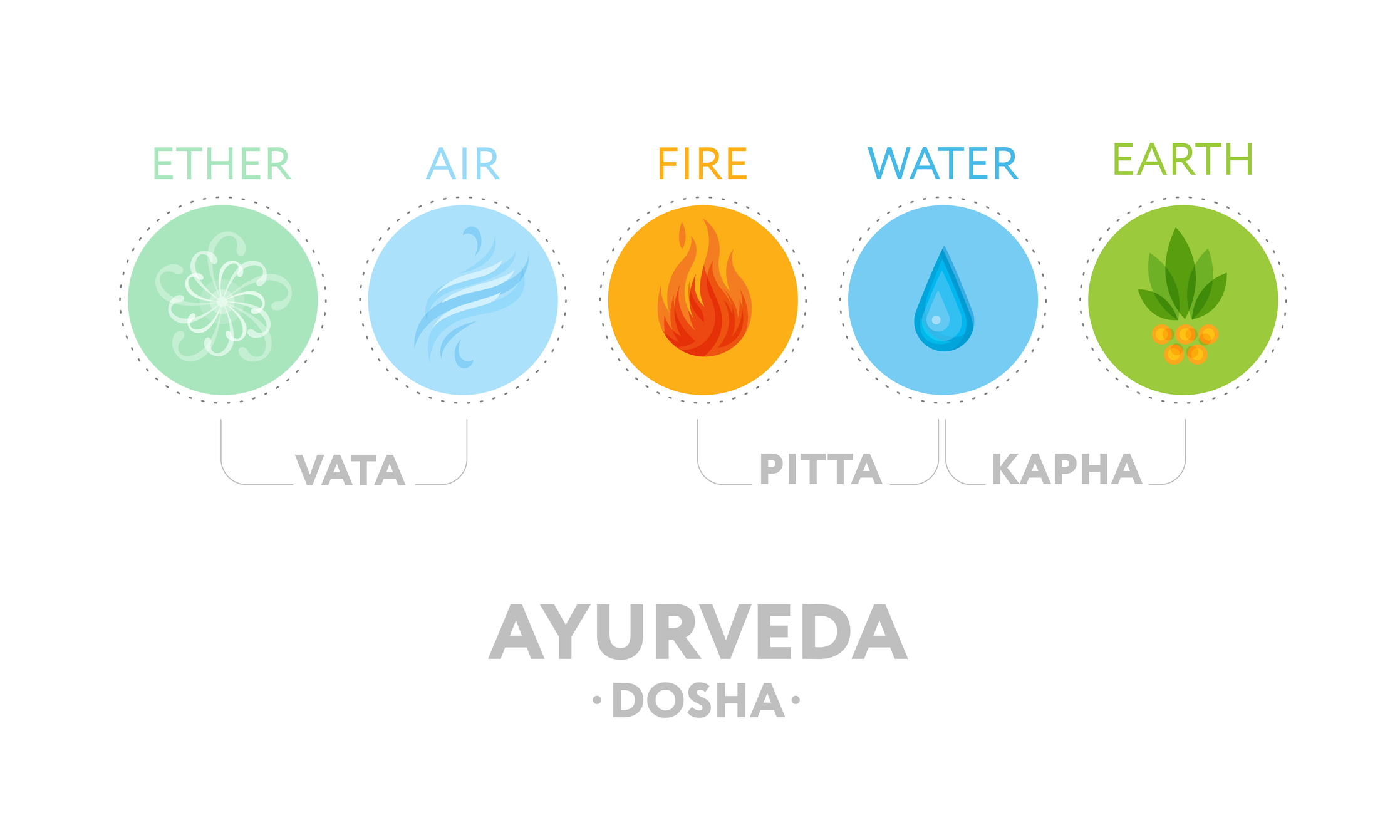
Ayurveda teaches us that when we live in sync with nature, we are able to find and maintain balance within ourselves. Nature is always changing and all of the plants and animals here on planet earth make shifts and adjustments to be in harmony with her. We need to do the same. It’s important to remember this as we move through through this beautiful life and experience shifts around us.
If you’re a bit familiar with Ayurveda, you may already be familiar with the Doshas. The Doshas are made up of the five elements: earth, air, fire, water, and ether. They are the forces that make up all of nature and govern all emotional, mental, and physical processes in our lives. There are three Maha (great) Doshas, known as: Kapha, Pitta, and Vata. The Doshas also govern the seasons and the times of the day and night!
A summary of the Doshas:
- Kapha Dosha is made up of earth and water and can sometimes be recognized as the part of us that’s caring and nurturing.
- Pitta Dosha is made up of fire and water and can sometimes be recognized as the part of us that’s passionate and driven.
- Vata Dosha is made up of air and ether and represents the creative, imaginative and social sides of us.
It’s important to remember that we actually are made up of all three Doshas, but the qualities of one or more may dominate the way we digest our food or even the way we learn. Let’s explore them more in depth below!
Kapha Dosha (Earth & Water)
Kapha dosha is made up of the elements earth and water and the qualities are heavy, cold, moist, static, smooth, and soft. When we think about what happens when earth and water combine, we may think about mud or even heaviness. However, earth and water actually provide us with feelings of being nurtured and being taken care of.
Kapha dosha is responsible for stability and structure within the body and also shows up as our ability to be supportive and caring to ourselves and others.
The main sites of kapha dosha are the stomach and the lungs.
The Kapha Dosha Archetype:
- They usually have strong bones, are very muscular, have lots of physical and mental strength, sometimes slow digestion, a slower walk, a booming voice, and a strong constitution.
- They love routine and rarely get bored of it. Since kapha’s really dislike changing their routine, they make some of the most loyal friends and partners!
- They don’t get sick too often, but when they do they’re probably more upset about being out of their daily routine. (They can eat the same thing every day for lunch and go on the same vacation ever year.)
- They are naturally loving and nurturing, but they also naturally hate change. The last thing they want to do is leave a steady relationship to explore something else.
- They work well with others and make great partners for projects or any kind of group activity.
- Their home is usually filled with lots of blankets, pillows, and anything that creates a cozy environment that welcomes naps and relaxation.
Kapha Season: Springtime
Kapha dosha’s season is springtime. During the spring, mother earth is moving through a phase where she’s melting the snow and ice while also creating an environment for new life and rebirth. Our bodies mirror what happens in nature, so we are naturally warming up and preparing for the new season and for change.
One of the main principles of Ayurveda is that like increases like and opposites balance.
If during the winter, we were drinking tons of cold smoothies and eating raw foods, we are increasing the cold quality that was already present in nature around us. By doing that, our incredibly intelligent bodies began to find ways to keep us warm and lubricated — so when spring comes, this additional lubrication may manifest as excess mucus or springtime allergies.
However, if a person ate warm soups and well-cooked foods during the winter, it would counter the cold qualities present in nature and the body wouldn’t need to find ways to come back to balance.
Kapha Time of Day: 6am-10am
The kapha times of day are 6am-10am and 6pm-10pm. If you’ve ever woken up at 8am and felt like you just wanted to go back to sleep or felt like it was impossible to get out of bed, it may be because you were waking up right in the middle of the kapha time of day. Remember, some of the qualities of kapha are heavy, slow, and dull. If you try to move and motivate when these qualities are dominant in nature, it’s naturally going to be more difficult.
I often have clients who come to me asking how they can break out of the morning fog they sometimes feel and how to get out of bed with more energy. The suggestion I always give is:
Try to wake up before kapha time begins. It might sound like waking up earlier would just mean that they’d be more tired, but waking up before those kapha qualities can be transformative. Waking up around 6am may also feel like a chore at first, but as soon as they get out of bed they say they actually have a lot of energy and motivation to start the day.
Another interesting thing about the kapha time of day is how it can work with us or against us when we are trying to go to sleep. If we can wind our day down between 6-10pm, which is kapha time, it’s much easier to get to sleep. Kapha’s slow and stable qualities work in our favor when we want to go to bed.
If you’ve ever been up past 10pm, you’ve probably experienced that “second wind” feeling where you get a burst of energy and are tempted to get some work done or even go out or begin a new project. If I ever find myself up at this time, I catch myself cleaning my home or doing the dishes or folding laundry and try to wind down. This may sound productive, but because I’m past that kapha time of night, it becomes much harder to get to sleep and stay asleep!
When Kapha is in balance:
- Maintaining nurturing relationships
- Lots of self love
- Love towards the people around us
- Stability at work
- Stability with a profession
When Kapha is out of balance:
- Swelling
- Excess mucus
- Weight gain
- Depression
- A sense of stagnation
- Inability to fully digest food
- Inability to process emotions
Pitta Dosha (Fire & Water)
Pitta dosha is made of the elements fire and water and some of the qualities are oily, hot, sharp, light, and spreading. When fire and water come together, it can create steam. When we think of steam, we probably imagine there being some sort of flame or heat to cause transformation. We need pitta to digest and transform our food and to also digest and transform our thoughts and emotions. We can see pitta within us whenever we are passionate about something and whenever we’re motivated. Those times when we feel unstoppable and incredibly driven are how we can recognize pitta within us.
One of the main sites of pitta dosha is the small intestine, which is where our food gets “cooked” and transformed into nutrients that move through our body.
The Pitta Dosha Archetype:
- They usually have a medium-sized frame, warm skin, light and intense eyes, an intense gaze, very strong digestion, and the ability to walk with intention and talk in an assertive way.
- They may gain and lose weight quite easily and also tend to be very athletic and active.
- They probably have their closet organized by color, season, or clothing type.
- Their bookshelves are most likely arranged by author or the books are set up in some kind of color-coded system.
- They probably know where everything in their home is located and it’s rare that something gets lost.
- They can take you on a wild adventure, jumpstart a new business, plan a huge event, and be the life of the party. However, remember that fire can be something that warms us as well as something that burns us.
Pitta Season: Summer
Pitta dosha’s season is summer and during the summertime we can see the qualities of pitta in mother nature. It can get incredibly hot and there’s also a sharp and spreading mood to the summer that can make us feel quite intense if we don’t encourage balance.
If it’s the afternoon on a hot summer day, when the sun is strongest and you’re already sweaty and warm, you will feel even more hot if you eat spicy salsa and take a high-intensity boot camp class outside. All of that heated activity would increase your pitta and bring you out of balance. You may act from a fiery place and respond with a fierce outburst in this case. We can avoid these fiery outbursts by keeping our pitta in balance. Perhaps instead of the salsa and bootcamp class, I could have drank coconut water and gone for a walk. Your mindset would have been much more cool and calm and you can react to situations in a more mindful way.
Pitta Time of Day: 10am-2pm & 10pm-2am
The pitta times of day are 10am-2pm and 10pm-2am. These times of day have qualities of pitta, so they’re the times of motivation and transformation. That 10am-2pm time of the day is the perfect time to tackle projects, make moves towards goals, schedule phone calls, and do anything that requires motivation and drive. It’s the best time to open up your planner or to-do-list and check things off. It’s also an ideal time to have the biggest meal of the day because our digestion is strongest.
The start of the evening, 10pm-2am time, might be when we experience a feeling of a “second wind,” which is basically just pitta time coming back around. Ideally, we want to be in bed, or at least trying to wind down, before evening pitta time kicks in. It’s a great time to be in bed because our bodies can experience more of a cleansing state when we’re relaxed and when we’re not digesting food. This is often a rough one for a lot of us with social lives that kick off later, but it can be such a transformational experience to honor this natural cycle in nature.
The beauty in understanding pitta dosha is that we can begin to notice where pitta shows up in our bodies, minds, hearts, lifestyle, and also in nature. When we are in sync with nature, we begin to feel more balanced as we move through our days and nights.
Understanding the doshas is meant to be empowering and a way for us to understand why we act a certain way or feed a certain way during specific times in our lives.
You may begin to notice that you aren’t really an angry or judgmental person, but rather that you were making certain lifestyle choices that increased your pitta and caused an imbalance. You may even start to see how certain people in your life are acting incredibly controlling because they haven’t taken a break in months and haven’t given themselves time to cool down and reset. Hopefully this knowledge helps us become more understanding, kind, and supportive towards ourselves and towards the people in our lives.
When Pitta is in balance:
- Ambition
- Leadership
- Passion
- Motivation
- Organization
When Pitta is out of balance:
- Digestion issues
- Anger
- Judgmental tendencies
- Irritability
- Overbearing
- Quick to make decisions without fully thinking things through
Vata Dosha (Air & Ether)
Vata dosha is made up of air and ether and can sometimes be recognized as the part of us that’s creative, imaginative, and social. Some of the qualities of vata are cold, light, dry, mobile, subtle. Air is literally all around us and is always moving. Even when we’re in total sillness, we can almost feel the air around our skin, eyes, nose, and ears. Ether is sometimes understood as space or stillness. It’s what can contain or hold. When air and ether come together to create vata dosha, there is potential for creation and also a container to just be.
The main sites of vata dosha are the large intestine, the pelvic area, the knees, skin, ears and hips.
The Vata Dosha Archetype:
- They usually have a long, straight frame, light bones and muscles, cool skin, cold hands and feet, and a slower walk.
- They tend to eat and talk fast and want to multitask all the time.
- It can be difficult for them to gain weight and it’s usually easy for them to lose weight.
- They may have a very dominant feature like large eyes, big teeth, or a more pronounced nose.
- They are social, creative, and also love to learn and travel.
- They need reminders and to-do-lists; Your vata friend is the one who you may not hear from for some time, and you’ll probably get a call from them at a very random time on a Tuesday because they want to tell you they were thinking of you and that they miss you.
Vata Season: Fall & Winter
Late fall and winter are considered vata season because it’s when we see many of vata’s qualities as mentioned above. When the weather begins to get cooler, we see nature naturally begin to dry up and get lighter. It becomes much windier and there is a crispness to the air that can only be felt during vata season.
During this time when our environment is naturally drying out, we need to maintain balance by favoring well-cooked, moist, and warm foods. It’s common to find that our appetite might increase as well and it’s okay to lean into that change. If you think about the lunch you have on a hot summer day vs the lunch you have on a cold winter day, the two are probably very different. Ayurveda teaches us that they should be different because the world around us is different during these times.
Vata season is a time to embrace routine. It’s important to try to wake up and go to sleep around the same time, eat meals around the same time, and do our best to have a predictable schedule. The mobile quality that comes with this season can cause imbalances within us if we aren’t finding ways to ground ourselves.
Vata Time of Day: 2pm-6pm & 2am-6am
The vata times of day are 2pm-6pm and 2am-6am. The daytime hours of vata from 2pm-6pm are when we may feel that afternoon crash or the need for a coffee or something sweet. This is a great opportunity to practice something nourishing like pranayama, meditation, or more mellow yoga classes. It’s a nice time to take a walk in nature and to also have a cup of tea. The late night and early morning hours of vata are a time to use the air and ether elements for receiving. It’s said that if we can wake up around 5-6am, it’s a very powerful time to meditate or to take part in whatever ritual or practice we have. It’s naturally a time with little distraction because most people are still asleep and all things in nature are just beginning to wake up.
The more we understand vata dosha and the qualities of vata, the more we can connect to nature around us and to the qualities within us. We can become more aware of how certain times of day, certain seasons, foods, situations, people, and places either help us come to balance, or cause us to fall out of balance. This awareness can hopefully help us become more understanding, supportive, and helpful to the people in our lives and to ourselves as we navigate this time on planet earth. When we begin to recognize how the doshas manifest for us, we can move through our day in a much more loving and understanding way. We can cultivate more compassion and become teachers who teach by example. The ability to teach people to find balance begins with us finding out how we can stay in balance.
When Vata is in balance:
- The ability to think on your toes
- Formulating new and helpful ideas
- Thinking outside the box
- Creative expression.
- Able to share ideas, plans and creations
When Vata is out of balance:
- Feelings of emptiness or lack







